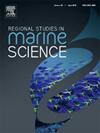奇利卡:热带沿海泻湖的微生物指标水平和环境影响
IF 2.4
4区 环境科学与生态学
Q3 ECOLOGY
引用次数: 0
摘要
微生物污染对全球沿海生态系统构成重大威胁;因此,定期监测病原微生物群落是确定沿岸水质健康的必要条件。目前的研究评估了奇里卡湖(热带亚洲最大的泻湖)的微生物污染水平,并调查了水文因素如何影响这些群落。采集了31个地点的地下水样品,并根据水温(WT)、盐度、总悬浮物(TSM)、溶解氧(DO)和亚硝酸盐(NO2)、硝酸盐(NO3)、氨(NH4)、磷酸盐(PO4)、硅酸盐(SiO4)、叶绿素-a (Chl-a)等理化参数对指示菌和致病菌进行了分析。结果表明,总大肠菌群的平均水平较高,为1.5 × 104 cfu/ml,表明可能来自污水污染,可能与南部地区的人类活动有关。粪便大肠菌群(FC)水平始终低于100 cfu/100 ml的安全限值,确保水质安全,适合娱乐活动和钓鱼。在湖的北部,河流的流入降低了盐度,由于光合活性的增加,这提高了Chl-a和溶解氧水平。Pearson相关分析显示,微生物总数与WT、DO、Chl-a和NO2、NO3等营养物质之间存在显著相关。本研究强调了采取生态措施恢复泻湖和保护其生态系统的必要性。它还强调了长期监测生态系统健康、加强旅游、渔业和娱乐决策的重要性。本文章由计算机程序翻译,如有差异,请以英文原文为准。
Microbial indicator levels and environmental influences in the Chilika: A tropical coastal lagoon
Microbial pollution poses a significant threat to coastal ecosystems globally; therefore, periodic monitoring of pathogenic microbial communities is essential for determining the health of coastal water quality. The current study assesses microbial contamination levels in Chilika Lake, the largest lagoon in tropical Asia, and investigates how hydrological factors influence these communities. Subsurface water samples were collected from 31 locations and analyzed for indicator and pathogenic bacteria with physicochemical parameters, including water temperature (WT), salinity, total suspended matter (TSM), dissolved oxygen (DO), and nutrients such as nitrite (NO2), nitrate (NO3), ammonia (NH4), phosphate (PO4), silicate (SiO4), and chlorophyll-a (Chl-a). The results indicated that high average levels of total coliforms, measuring 1.5 × 104 cfu/ml, suggest potential contamination from sewage, likely associated with human activities in the southern region. Faecal coliform (FC) levels consistently remained below the safe limit of 100 cfu/100 ml, ensuring the water was safe for recreational activities and fishing. In the northern sector of the lake, river inflow reduced salinity, which enhanced Chl-a and dissolved oxygen levels due to increased photosynthetic activity. Pearson correlation analysis revealed significant relationships between total microbial populations and various environmental variables, including WT, DO, Chl-a, and nutrients such as NO2 and NO3. This study emphasizes the need for ecological measures to restore the lagoon and safeguard its ecosystem. It also underscores the importance of long-term monitoring for ecosystem health, enhancing tourism, fishing, and recreation decision-making.
求助全文
通过发布文献求助,成功后即可免费获取论文全文。
去求助
来源期刊

Regional Studies in Marine Science
Agricultural and Biological Sciences-Ecology, Evolution, Behavior and Systematics
CiteScore
3.90
自引率
4.80%
发文量
336
审稿时长
69 days
期刊介绍:
REGIONAL STUDIES IN MARINE SCIENCE will publish scientifically sound papers on regional aspects of maritime and marine resources in estuaries, coastal zones, continental shelf, the seas and oceans.
 求助内容:
求助内容: 应助结果提醒方式:
应助结果提醒方式:


